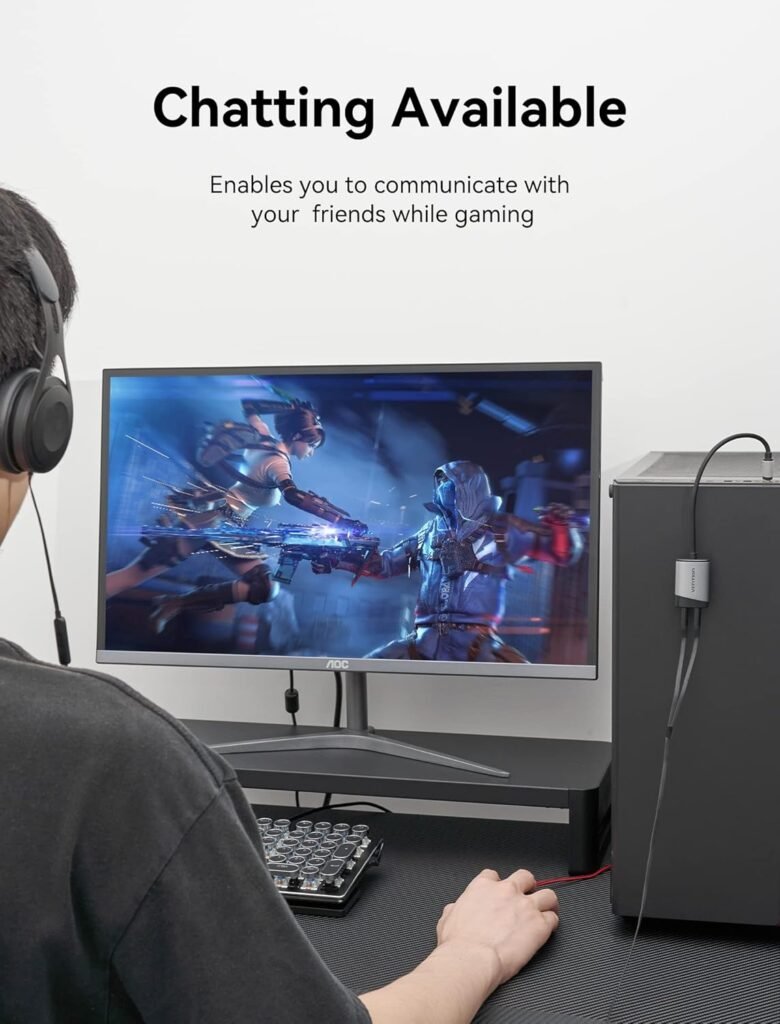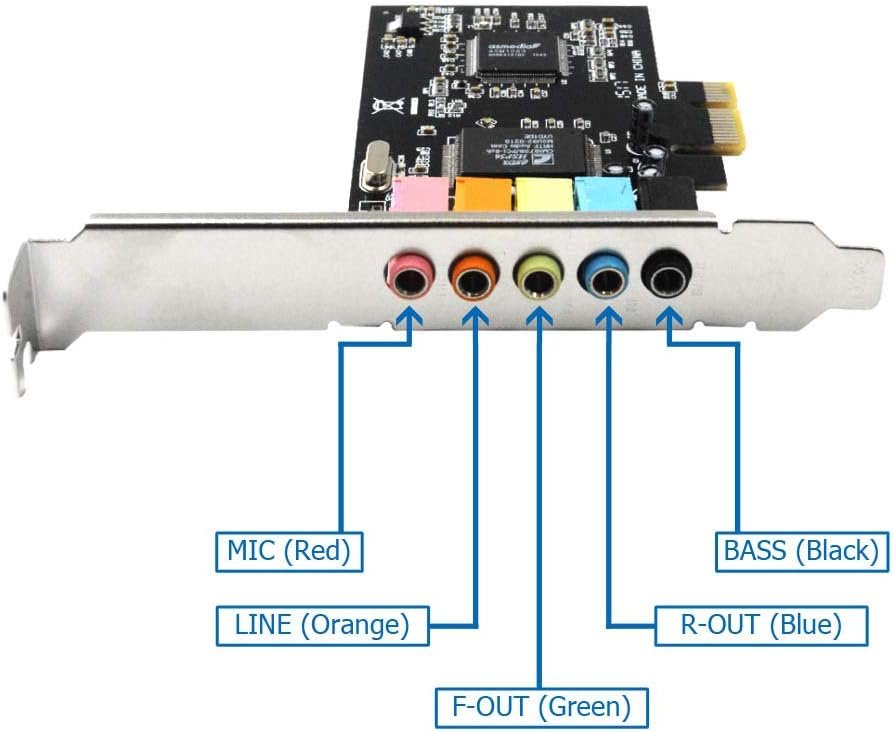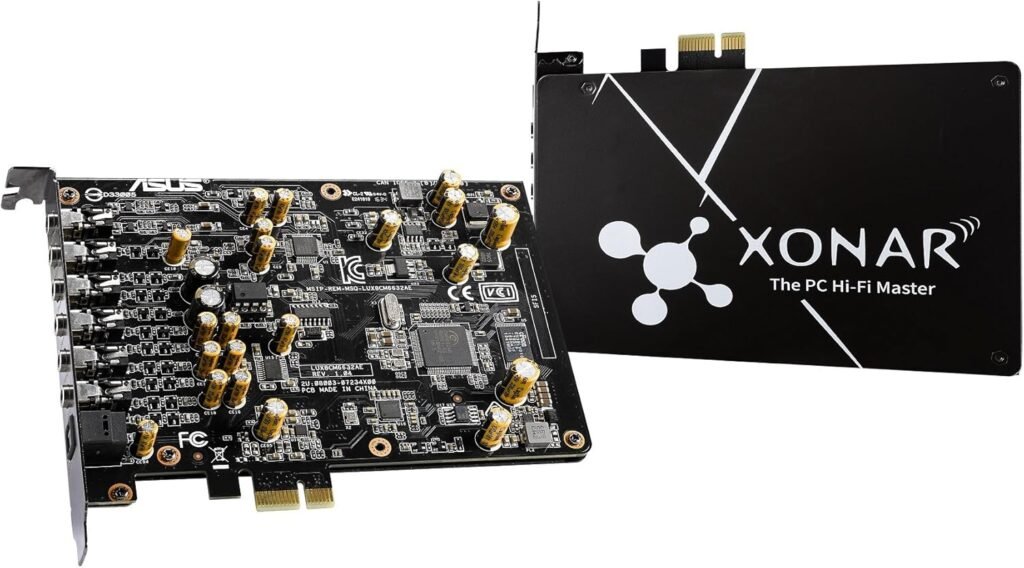It’s funny how we take sound for granted until it suddenly becomes relevant. I remember the first time I listened to music through a cheap pair of earbuds plugged into my laptop. The bass was muffled, the vocals were distant, and I was left wondering if I’d accidentally stumbled into a live recording from an underground bunker. Fast forward to today, I find myself surrounded by a menagerie of sound cards, each promising to elevate my auditory experience to new heights. From the VENTION USB Sound Card, which is about as straightforward as a sock drawer, to the sophisticated Asus Xonar AE, these little devices can make all the difference when it comes to listening to music, gaming, or even conducting long Zoom meetings.
Historically, sound cards have been the unsung heroes of the audio world, quietly transforming the raw digital signals from our computers into the sounds we cherish. It all began back in the 1980s, with basic audio output cards that made those clunky desktop computers able to produce simple melodies and sound effects. Today, they’re like the fancy tuxedos of the tech world—some for everyday, casual listening, while others are designed with audiophiles in mind, catering to every sonic whim. The benefits of owning a dedicated sound card, whether external or internal, are abundant; they usually enhance audio quality, allow for surround sound, and offer better controls, turning the simple act of listening into an experience. In this article, I’ll be taking you through these different products, examining their features and help you understand which one might suit your needs best. So, let’s tune in, shall we?
VENTION USB Sound Card – External Stereo Audio Adapter with Volume Control for Windows, Mac, PC, and More
When diving into the world of external sound cards, I often wonder how well they can enhance my audio experience—especially for gaming and multimedia consumption. The VENTION USB Sound Card stands out as a top contender in this arena. Primarily, I aim to use this device for everyday activities like gaming, video chatting, listening to music, and enjoying movies. It comes as a handy solution for anyone who needs a straightforward way to upgrade their audio output without tangled wires or complex setups.
One of the major pluses of the VENTION USB Sound Card is its sheer simplicity. No drivers required? Yes, please! Most of the time, when I’m looking for a gadget, I don’t want to delve into complicated installations. This little box enables a plug-and-play experience that makes life infinitely easier. The fact that it has a volume control knob gives me immediate access to adjust audio levels on the fly. It’s convenient while gaming, letting me quickly mute my mic or turn up the sound while losing myself in an intense match.
The VENTION USB Sound Card is designed to be an efficient replacement for traditional sound cards, specifically catering to users who need easy compatibility with devices that sport a USB port. This device can accommodate normal stereo sound and works seamlessly with various headsets, including those designed for gaming. Its features include:
-
USB to 3.5mm Jack Audio Adapter: This connectivity offers flexibility, allowing me to use my favorite earbuds, headphones, or even a gaming headset on multiple devices—Windows, Mac, PC, and more.
-
No Drivers Needed: Simply plug it in, and I’m ready to rock! Instant setup means more gaming and less tinkering around with software.
-
Easy Volume Control: The volume knob lets me adjust sound levels without diving into software settings, which is a real time-saver.
-
Wide Compatibility: I can use it with numerous systems, including modern Windows versions, Mac OS, Android, and even gaming consoles like the Switch. It’s perfect for someone like me who switches between devices regularly.
-
Compact Size: Its travel-friendly design means I can easily toss it in my bag when heading out.
I’ve had a chance to really put the VENTION USB Sound Card through its paces, and so far, it hasn’t disappointed. The audio quality is impressive for such a compact device. The sound clarity and depth surpass my expectations, especially considering its price point. It efficiently handles both input and output without lag or distortion, making it ideal for serious gamers and casual listeners alike.
The lack of need for extra drivers further enhances its practicality. Plus, the construction feels solid; it doesn’t seem cheap or flimsy, which is often a concern when dealing with budget audio equipment. Whether I’m playing a fast-paced game or enjoying a relaxing music session, the quality holds up beautifully.
-
User-Friendly Design: The plug-and-play setup is incredibly user-friendly. It doesn’t require any in-depth tech knowledge.
-
Fantastic Compatibility: Works with a wide range of devices—perfect for someone who juggles between different platforms.
-
Decent Audio Quality: It surprisingly delivers clear and rich sound, good enough for both gaming and music listening.
-
Volume Control: The knob is a game-changer for adjusting sound instantly, especially during gaming or calls.
-
Portable: Lightweight and compact, it’s easy to take anywhere I need it.
-
Limited Features: While it gets the basics right, advanced users might find it lacking features like customizable EQ settings.
-
Plastic Build: Although the build quality is solid, it’s primarily plastic, which could be perceived as less premium compared to some higher-end counterparts.
-
No Extra Ports: Some competitors offer additional USB or audio ports, but this one sticks strictly to a single 3.5mm connection.
In terms of value for the price, I find the VENTION USB Sound Card hard to beat. While it might not completely replace high-end sound cards for audiophiles, it sure holds its ground for everyday users like me who want a reliable audio fix without breaking the bank. It performs beautifully, offers fantastic compatibility, and elevates audio quality across platforms. What’s not to love?
PCIe 5.1 Internal Sound Card for PC with Low Profile Bracket, 3D Stereo Audio Card, CMI8738 Chip
When I first unboxed the PCIe Sound Card, I couldn’t help but think about how it could elevate my audio experience while gaming and watching movies. This internal sound card truly aims to give you that cinematic experience right from your PC. For anyone who’s serious about sound quality, whether you’re gaming, streaming, or enjoying your favorite music, this card delivers.
One of the standout features for me is how easy it is to install. I wasn’t sure if I was going to have a challenging time integrating it into my existing setup, but it turned out to be straightforward. The low profile bracket was a thoughtful addition, allowing it to fit snugly in even compact cases. I appreciate how this sound card balances performance and usability without complicating the process. Plus, the 5.1 surround sound capability transforms the mundane audio setup into something special.
The primary purpose of the 5.1 Internal Sound Card is to enhance your PC’s audio capabilities. By converting your standard setup into a 3D stereo surround sound experience, it creates an atmosphere that pulls you into your favorite media, giving it that “wow” factor.
- 16-bit Multimedia Digital Signal Editing Decoder: This feature allows for precise audio processing, making it perfect for both recording and playback.
- Supports 32/64-bit Audio Processing: Irrespective of your operating system architecture, this card works smoothly, carrying high-definition sound quality across various platforms.
- Direct Sound, A3D, and EAX: These technologies expand audio dimensions, allowing your sound to envelop you fully, hitting you from all angles.
- HRTF 3D Tone: This is what immerses you deeply into sound environments, whether you’re hearing the rustling of leaves behind you or the thud of footsteps approaching; it all feels natural.
The compatibility with multiple Windows versions (Windows 2000, NT, XP, 7, and 8) ensures that I can use this sound card across various systems without worrying about losing functionality.
Now, let’s talk about overall quality. The build quality of the PCIe sound card felt solid the moment I installed it. I mean, you can usually tell a lot about a product just by the feel of it, right? The material isn’t flimsy, and the ports were easy to connect. There’s something comforting about knowing I’m using a product that’s built to last.
The audio quality? Wow, that’s where the magic happens. I noticed the difference right away when I booted up a new AAA game. The 3D stereo surround sound made the environment feel alive—as if I was stepping into the game rather than just playing it. It’s now become almost a necessity for my gaming nights. Even in movies, the sound effects came through with a detail and clarity I didn’t know I was missing!
Every product has its merits and downfalls, and the PCIe sound card is no exception. Here’s what I found:
-
Excellent Sound Quality: The immersive 5.1 surround sound is definitely its biggest selling point for both games and movies.
-
Easy Installation: The low profile bracket means I could fit it comfortably in my case without any hassle.
-
Wide Compatibility: Works seamlessly with older Windows operating systems, making it versatile for different setups.
-
Great for Gaming: The 3D sound features take gaming audio to another level, adding extra life to soundscapes.
-
Limited Advanced Features: For audiophiles, it may lack some more sophisticated sound processing options found in higher-end cards.
-
Driver Updates: Depending on your OS, you might have to hunt a bit for the best drivers for optimal performance. It’s not a showstopper, but something to consider.
-
Physical Size Limitations: While the low profile design is appealing, it may not suit everyone. If you’re looking for something with more ports or expansion options, this may feel a bit limiting.
I’ve thoroughly enjoyed my experience with this PCIe Sound Card. It really does what it claims: enhances audio capabilities and creates a more immersive experience. If you’re like me and appreciate quality sound without breaking the bank, this card might just be the upgrade your PC has been waiting for.
Asus Xonar AE Audio Card
When I decided to upgrade my audio experience, I knew that I needed a dedicated sound card to fully appreciate the nuances of my favorite tunes and games. The Asus Xonar AE Sound Board quickly caught my attention, mainly thanks to its strong reputation among audiophiles and gamers alike. This sound card is designed primarily for PC use, making it a perfect fit for anyone looking to enhance their audio setup without breaking the bank.
What’s not to love about the Xonar AE? It offers a lot of bang for your buck, and I’ve found it to be the perfect solution for my specific needs. The combination of features, build quality, and sound output makes it a fantastic choice for both casual listeners and more critical users. I appreciate how it improves my overall listening experience, making even the most mundane tasks feel epic. Plus, it’s surprisingly easy to install and configure, which is always a bonus for someone like me who doesn’t want to deal with technical headaches.
The Asus Xonar AE Sound Board is all about delivering high-fidelity audio and optimizing gaming soundscapes. The key features that really sold me include:
-
C-Media Audio Processor Model: 6632AE: This processor is at the heart of the Xonar AE, providing excellent sound processing capabilities. Its clear output and well-structured sound reproduction made my music and gaming experience richer and more engaging.
-
Host Interface: PCI Express: Using a PCIe interface not only ensures a stable connection but also allows for great bandwidth, essential for high-quality audio processing. It’s designed to prevent latency, something I appreciate when I’m gaming or watching movies.
-
Signal to Noise Ratio (SNR): 110 dB: This impressive SNR means that I can enjoy my audio without worrying about background noise. It translates to clearer highs and defined lows, enhancing my overall listening experience significantly.
The Xonar AE aims to provide a premium audio experience without the hefty price tag that often comes with high-end audio gear.
The overall quality of the Xonar AE is something I notice immediately upon its use. The sound is vibrant and dynamic, which makes it perfect for gaming and listening to music. I often find that I can hear details in tracks that I’ve listened to for years but never noticed before. From the subtle nuances in my favorite jazz albums to intense explosions in games, this sound card has elevated my auditory experience.
The build quality is also commendable. The card itself feels sturdy and well-made, which is reassuring. When I installed it in my PC, it slotted right into place without any hassle. The ye olde days of wrestling with hardware are behind me, thanks to the Xonar AE’s user-friendly design.
-
Exceptional Sound Quality: The clarity and depth of sound provided by the Xonar AE are impressive. Every frequency seems well-balanced, making it suitable for various audio tasks, from serious listening to casual gaming.
-
Easy Installation: Being a PCIe sound card, the installation was straightforward. It took moments, and the drivers installed without any hiccups.
-
Great Value: For the price, you get features and quality that often outperform competitors in the same range. This card feels like it’s been designed for budget-conscious users who still want great audio.
-
Compatibility: Works seamlessly with a range of operating systems and setups. Whether I’m using it for gaming or music, the card adapts well without struggle.
-
Limited Software Features: While the performance is solid, the accompanying software could offer more functionality. I sometimes find myself wanting additional equalization options to fine-tune my listening experience.
-
No USB Connectivity: Some might miss the convenience of a USB connection, especially if you’re transitioning from an external sound card. It’s a minor inconvenience, but worth noting.
-
Heatsink Size: The card’s heatsink might take up noticeable space in a tight PC build, which could be a concern for users with compact cases.
-
Driver Updates: Although I didn’t face significant issues, some users online have reported that driver updates are occasionally slow in coming. It’s not a deal-breaker for me, but I recognize that updates can be vital for optimizing performance over time.
In my experience, the Asus Xonar AE Sound Board stands as a compelling option in the sound card market. It effectively combines high-quality audio performance, ease of use, and affordability. I’ve genuinely enjoyed every aspect of upgrading to this sound card, and I recommend it to anyone looking to revitalize their audio experience. Whether you’re a gamer or an audiophile, the Xonar AE is likely to impress you just as it did me.
Comparing the VENTION USB Sound Card, PCIe Sound Card, and Asus Xonar AE Sound Board
When delving into the world of external sound cards and audio adapters, it often feels like diving into a sea full of choices. I must admit, I’ve been on my own audio adventure, navigating through the options offered by the VENTION USB Sound Card, the PCIe Sound Card, and the charming Asus Xonar AE Sound Board. Each product has its quirks, specifications, and that distinct “voice” that can make or break my listening experience. So, I decided to lay it all out in a way that even a sound bar skeptic could appreciate. Ready? Let’s dive in!
Product Specifications Breakdown
To make my comparison clearer, I compiled some specifications in a handy table. This way, I can compare them side by side—just like a friendly neighborhood competition!
| Feature | VENTION USB Sound Card | PCIe Sound Card | Asus Xonar AE Sound Board |
|---|---|---|---|
| Type | External USB Audio Adapter | Internal PCI Express Sound Card | Internal Sound Card |
| Audio Channels | Stereo | 5.1 Surround Sound | 7.1 Surround Sound |
| Compatibility | Windows, Mac, Linux, Android, Switch | Windows 2000, XP, 7, 8 | Windows 10/8.1/8/7/XP |
| Volume Control | Yes, with knob | N/A | Yes, with software control |
| Drivers | No drivers required | Requires installation | Requires installation |
| Signal to Noise Ratio | Not specified | 110 dB | 108 dB |
| Portable? | Yes, compact design | No, internal installation required | No, internal installation required |
| Best Use Cases | Gaming, video chatting, music | Gaming, multimedia, content creation | High-fidelity audio playback and gaming |
| Chipset | N/A | C-Media 6632AE | Asus exclusive chip |
My Thoughts on Each Product
VENTION USB Sound Card
The VENTION USB Sound Card has quickly become my beloved sidekick. Its compact and portable design means I can toss it in my bag and be ready to rock anywhere I find a USB port. The plug-and-play feature is a total win for me—there’s nothing worse than fumbling with software before I can listen to my favorite tunes. I appreciate the volume control knob, putting me in charge of my sound. However, it’s important to note that it only supports stereo, which might be a bit of a letdown for anyone craving that full surround sound experience.
PCIe Sound Card
Now, the PCIe Sound Card is a different beast altogether. It’s more of a traditional option, tucked away inside your PC’s casing. What I love about this card is its capacity for 5.1 surround sound, transforming my gaming and movie-watching experience into something cinematic. It’s packed with powerful specs, and despite needing some installation tedium, I find it worthwhile during my gaming marathons. The only downside is that it doesn’t have volume control knobs; I’d have to adjust sounds from my operating system, which breaks my immersion a tad.
Asus Xonar AE Sound Board
Lastly, the Asus Xonar AE Sound Board feels like a luxury audio upgrade. With its 7.1 surround sound capability, it’s like placing myself right in the center of the action. I’ve found that the audio fidelity is top-notch, making it the preferred choice for audiophiles. However, it does come with the expectation of some installation fuss, much like the PCIe card, and it may not be the best fit for someone looking for simplicity. Plus, it boasts impressive specifications, although it requires software control for the best experience.
In Conclusion
At the end of the day, my choice depends on what I’m looking for in my sound experience. For easy plug-and-play functionality and portability, the VENTION USB Sound Card is fantastic. For dedicated home setup enthusiasts, the PCIe Sound Card and the Asus Xonar AE truly shine. Just like Goldilocks, I find myself navigating varying levels of complexity—sometimes it’s all about simplicity, and other times, I crave immersion. What about you? What’s your preference in the world of sound?
Wrapping It Up: An Audio Adventure
As I journeyed through the world of audio adapters and sound cards, I encountered three noteworthy products: the VENTION USB Sound Card, the PCIe Sound Card with CMI8738 Chip, and the Asus Xonar AE Sound Board. Each of them brings its own flair and functionality to the table, but not without some quirks along the way.
The VENTION USB Sound Card: Simple and Effective
The VENTION USB Sound Card is like that reliable friend who always shows up when you need them. With its plug-and-play design and handy volume control, it’s perfect for those who want to enhance their audio experience without diving deep into tech jargon. It worked seamlessly across my various devices—Windows, Mac, you name it. However, while its simplicity is a strength, I did notice that the audio quality was just a tad flat compared to the other options. It’s great for casual use, but audiophiles might find themselves yearning for something more robust.
The PCIe Sound Card: The Understated Champion
Next up, we have the PCIe Sound Card. Oh, what a hidden gem this one is! With its low profile and 3D stereo capabilities, it really packs a punch. It’s perfect for gamers and those into multimedia creation who need quality sound without taking up much space. However, I did run into some installation hiccups. Getting it to work on my older system felt like a game of Monopoly: frustratingly slow and full of surprises. If you’re tech-savvy and don’t mind tinkering a bit, this card could become your best buddy.
The Asus Xonar AE Sound Board: The Premium Choice
Finally, we have the Asus Xonar AE Sound Board. Now, this is where things get interesting. With excellent sound quality and numerous features, it almost felt like listening to my favorite album for the first time again. But, let’s face it, its premium price tag might make one think twice—especially if you’re just looking for basic audio enhancement. This one is for the serious audiophiles, gamers, and content creators who want professional-grade sound quality and can justify the investment.
A Recommendation for Everyone
In conclusion, if you’re a casual listener or just need something easy to set up, the VENTION USB Sound Card is my go-to recommendation. For gamers and tech enthusiasts who enjoy a little adventure with their hardware, the PCIe Sound Card would be right up your alley. However, if you’re an audiophile or someone who demands the best from your audio experience, the Asus Xonar AE is worth every penny to truly elevate your sound game.
So, whether you’re looking to charge through video games or simply crank up your tunes, there’s a little something for everyone among these audio treasures. Happy listening!
Disclosure: As an Amazon Associate, I earn from qualifying purchases.






